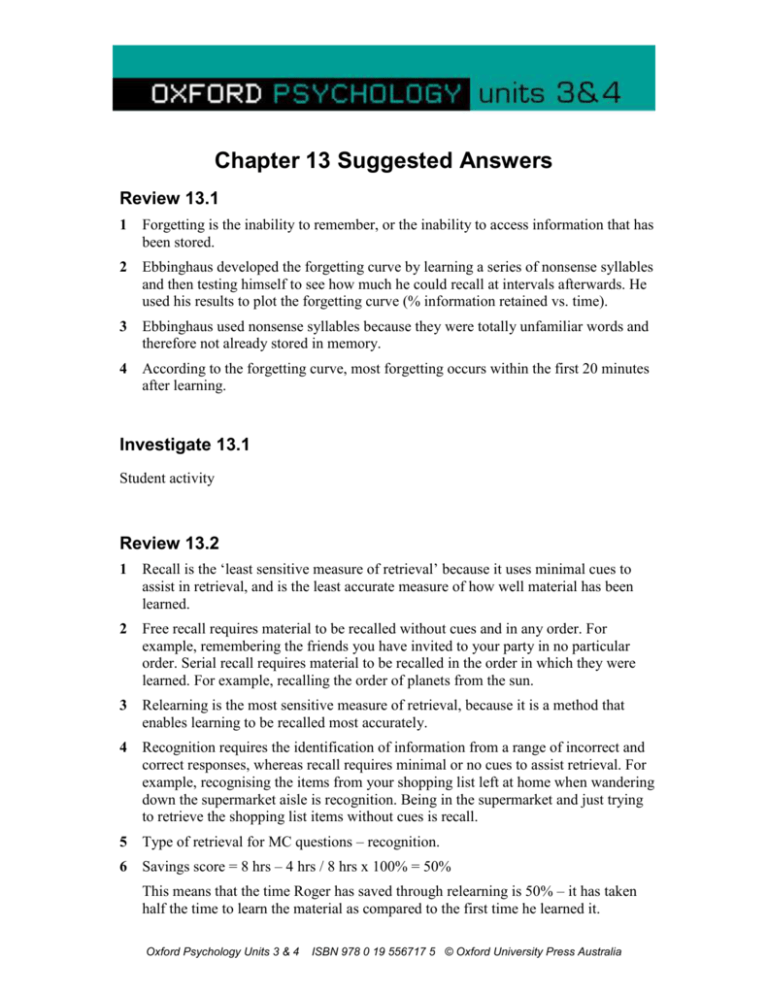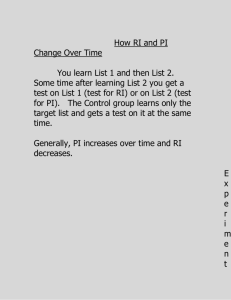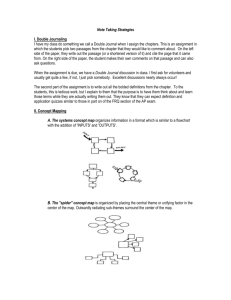Chapter 1 - Oxford University Press
advertisement

Chapter 13 Suggested Answers Review 13.1 1 Forgetting is the inability to remember, or the inability to access information that has been stored. 2 Ebbinghaus developed the forgetting curve by learning a series of nonsense syllables and then testing himself to see how much he could recall at intervals afterwards. He used his results to plot the forgetting curve (% information retained vs. time). 3 Ebbinghaus used nonsense syllables because they were totally unfamiliar words and therefore not already stored in memory. 4 According to the forgetting curve, most forgetting occurs within the first 20 minutes after learning. Investigate 13.1 Student activity Review 13.2 1 Recall is the ‘least sensitive measure of retrieval’ because it uses minimal cues to assist in retrieval, and is the least accurate measure of how well material has been learned. 2 Free recall requires material to be recalled without cues and in any order. For example, remembering the friends you have invited to your party in no particular order. Serial recall requires material to be recalled in the order in which they were learned. For example, recalling the order of planets from the sun. 3 Relearning is the most sensitive measure of retrieval, because it is a method that enables learning to be recalled most accurately. 4 Recognition requires the identification of information from a range of incorrect and correct responses, whereas recall requires minimal or no cues to assist retrieval. For example, recognising the items from your shopping list left at home when wandering down the supermarket aisle is recognition. Being in the supermarket and just trying to retrieve the shopping list items without cues is recall. 5 Type of retrieval for MC questions – recognition. 6 Savings score = 8 hrs – 4 hrs / 8 hrs x 100% = 50% This means that the time Roger has saved through relearning is 50% – it has taken half the time to learn the material as compared to the first time he learned it. Oxford Psychology Units 3 & 4 ISBN 978 0 19 556717 5 © Oxford University Press Australia Review 13.3 1 The ‘encoding specificity principle’ according to Tulving means that the associations we form at the time of encoding material are the most effective cues for retrieving the information. If we retrieve the material under the same conditions as when we learned it we are more likely to remember it. 2 Context-dependent cues are those that rely upon an environmental cue for retrieval. For example, a student is sitting an exam in the classroom. She learned the information, so she will be more likely to recall the material through the cues from the same environment. State-dependent cues are those that relate to internal cues such as emotions for recalling information. We are more likely to remember other occasions in which we were anxious when we are experiencing that state. Investigate 13.2 1 Aim: To find out if learners were able to remember information better when in the same environment as learning. 2 IV: learning environment DV: number of words recalled 3 Experimental hypothesis: Subjects learning words in a specific environment will be able to recall more words when recalling in the same environment. 4 Conclusion: Subjects were better able to recall words when in the same environment as they learned the information. 5 Two ethical principles (any two from): withdrawal rights, voluntary participation, informed consent, debriefing. Investigate 13.3 1 Aim: To find out if learners were able to remember information better when in the physiological state as learning. 2 IV: learning environment (resting or pedalling on exercise bike) DV: number of words recalled 3 Experimental hypothesis: Subjects learning words when exercising will be able to recall more words (when exercising). Oxford Psychology Units 3 & 4 ISBN 978 0 19 556717 5 © Oxford University Press Australia 4 Findings: Subjects were better able to recall words when in the same physiological condition as when they learned the information. 5 Two potential ethical issues: those in exercise group may have a health issue that is exacerbated by exercise; having to exercise may be distressing for some subjects. Investigate 13.4 Student activity Investigate 13.5 Student activity (internet research) Investigate 13.6 1 Sequential presentation of possible suspects is a more reliable method of identification because it allows the witness to study the features of each person carefully. When presented with simultaneous photographs/line-up, an eyewitness can choose a line-up member based upon relative judgment rather than on their own mental image of the suspect. 2 A double-blind procedure in a suspect line-up is critical in eyewitness identification. This means that neither the person conducting the line-up or the eyewitness know who the most likely suspect is. If the person conducting the lineup knows, they may unintentionally give hints or information that may bias the eyewitness. 3 The witness must be made aware that the suspect may not be in the line-up; otherwise they may choose the ‘closest’ resemblance and therefore the wrong person. 4 If non-suspects or fillers are chosen for their likeness to the suspect, the wrong person (an innocent person) may be selected by the eyewitness. They should be chosen for their similarity to the description instead. 5 These procedures can help to overcome problems with eyewitnesses reconstructing events more accurately because they require the eyewitness to use their own recollections of the details rather than having them inaccurately reconstruct their memory. An inaccurate reconstruction can lead an eyewitness to believe that their new memory of the suspect/event is real. Oxford Psychology Units 3 & 4 ISBN 978 0 19 556717 5 © Oxford University Press Australia Test your Understanding 1 c 2 c 3 b 4 b 5 a 6 c 7 b 8 c 9 c 10 d 11 d 12 a 13 d 14 c 15 a 16 Two features of Ebbinghaus’ learning curve: almost 50% information is forgotten in first 20 minutes; gradual decline in retained information over 31 days. 17 Measures of retention: Least sensitive: recall Moderately sensitive: recognition Most sensitive: relearning 18 Memory may be improved by following examples: a. Narrative chaining: to remember a shopping list, chain the items into a story that is meaningful yet bizarre and visual to aid recall of items in order. The apples slid down the magazine to land in a cereal bowl and splash milk everywhere! Oxford Psychology Units 3 & 4 ISBN 978 0 19 556717 5 © Oxford University Press Australia b. Context-dependent cues: visiting your old primary school classroom will help to recall old primary school friends and things that happened in that classroom. 19 Memory may be improved by following examples: a. Method of loci: visualising items for shopping list by associating with locations around bedroom as walk around and link items with objects in room. Visualise: carrots hanging off the back of the door; pumpkin stuffed into bedside drawer; broccoli in pockets of dressing gown; asparagus hair on teddy; potatoes hiding under rug. b. State-dependent cues: feeling exhilarated when hopping off the roller coaster triggers a memory of going to Disneyland and going on a ride there that created the same feeling. 20 The word ‘hit’ is likely to initiate a slower estimated speed that cars were travelling as compared to the word ‘smashed’. 21 Factors involved in reconstructive memories are: putting fragments of memory together and filling in gaps with details that appear that they should fit (preconceived ideas). These ideas become reinforced over time so that we can believe they are true, when in fact they can be inaccurate reconstructions. Oxford Psychology Units 3 & 4 ISBN 978 0 19 556717 5 © Oxford University Press Australia






